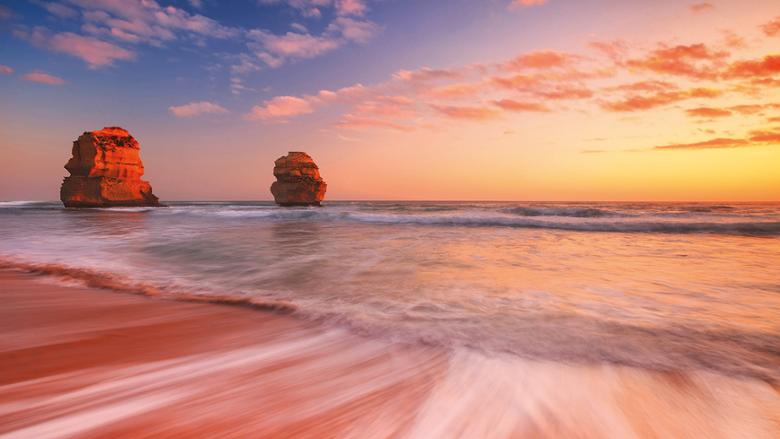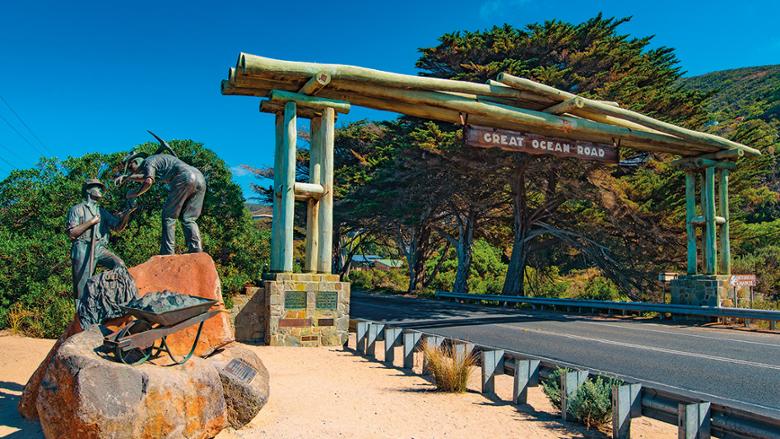Road trip across The Great Ocean Road
For a close look of Australia’s stunning landscape, Sarah Marshall suggests a road trip kissing the south-eastern coastline
Few forces could challenge the power of an angry ocean. In a battle between land and water, fierce waves have conquered Australia’s south-eastern coastline, lashing against millennia-old cliffs to create a scenic stretch of sculpted archways, limestone stacks and hidden bays.
Dramatic and awe-inspiring, it’s a fitting location for the world’s largest war memorial – a thrilling coastal road built by more than 3,000 soldiers between 1919 and 1932 in memory of 60,000 comrades killed in the First World War.
Running for 151 miles through Victoria, from surf capital Torquay to small town Allansford, The Great Ocean Road is a wild, windswept driving route, which – at times – feels like it could be leading to the end of the earth. Thread along ochre cliffs soaring above sparkling beaches and tunnel through ancient forests where even the sound of tumbling waterfalls fails to rock sleepy koalas from their treetop cribs.
Stop at an inexhaustible selection of unique viewpoints to appreciate the strength of the Southern Ocean, watching waves roll thousands of miles from the ice shelves of Antarctica across some of the most treacherous waters to navigate. Then continue to swimmable, sheltered bays where the surf trickles lazily to shore.

Among the route’s essential stops is Erskine Falls, six miles from Lorne in the Great Otway National Park. Fresh water cascades down a vertical staircase of rocks carpeted in lime-green mosses and ticked by the fronds of enormous ferns. A strenuous hike to the second lookout point offers the best views.
Indigenous wildlife can be encountered at any point, but for (near) guaranteed sightings head to the newly opened Wildlife Wonders eco-tourism attraction at Apollo Bay (wildlifewonders.org.au). A one-hour walk led by a conservation guide winds through protected bushland habitat for kangaroos, potoroos and bandicoots.
The biggest highlight of the drive, however, is the Twelve Apostles – a collection of limestone stacks isolated by erosion and gobbled by the waves. Seven of the marine monoliths remain offshore from Port Campbell National Park, all visible from clifftop trails or even helicopter sightseeing tours.
More natural sculptures are scattered along the coastline. Nearby, giant towers Gog and Magog can be seen from sea level by descending a natural staircase of 86 steps carved into the rock, tracing a path once used by the indigenous Kirrae Whurrong people. The Grotto, The Arch and Loch Ard Gorge – a steep-sided, sparkling bay laced with walking trails – are all additional highlights.
Longer days and less rain make the summer months between December and February an obvious time to visit. But this period coincides with Australian school holidays – so expect crowds. Alternatively, the shoulder seasons are also pleasant, much quieter and cheaper: expect mild in autumn (March to May) and carpets of wildflowers in spring (September to November). If you can brace the cold, winter can be dramatic. Watch mighty waves charge from stormy horizons; listen to the rush of waterfalls swollen with rainfall; and spot whales making their journey to the icy south.
The Daily Telegraph

